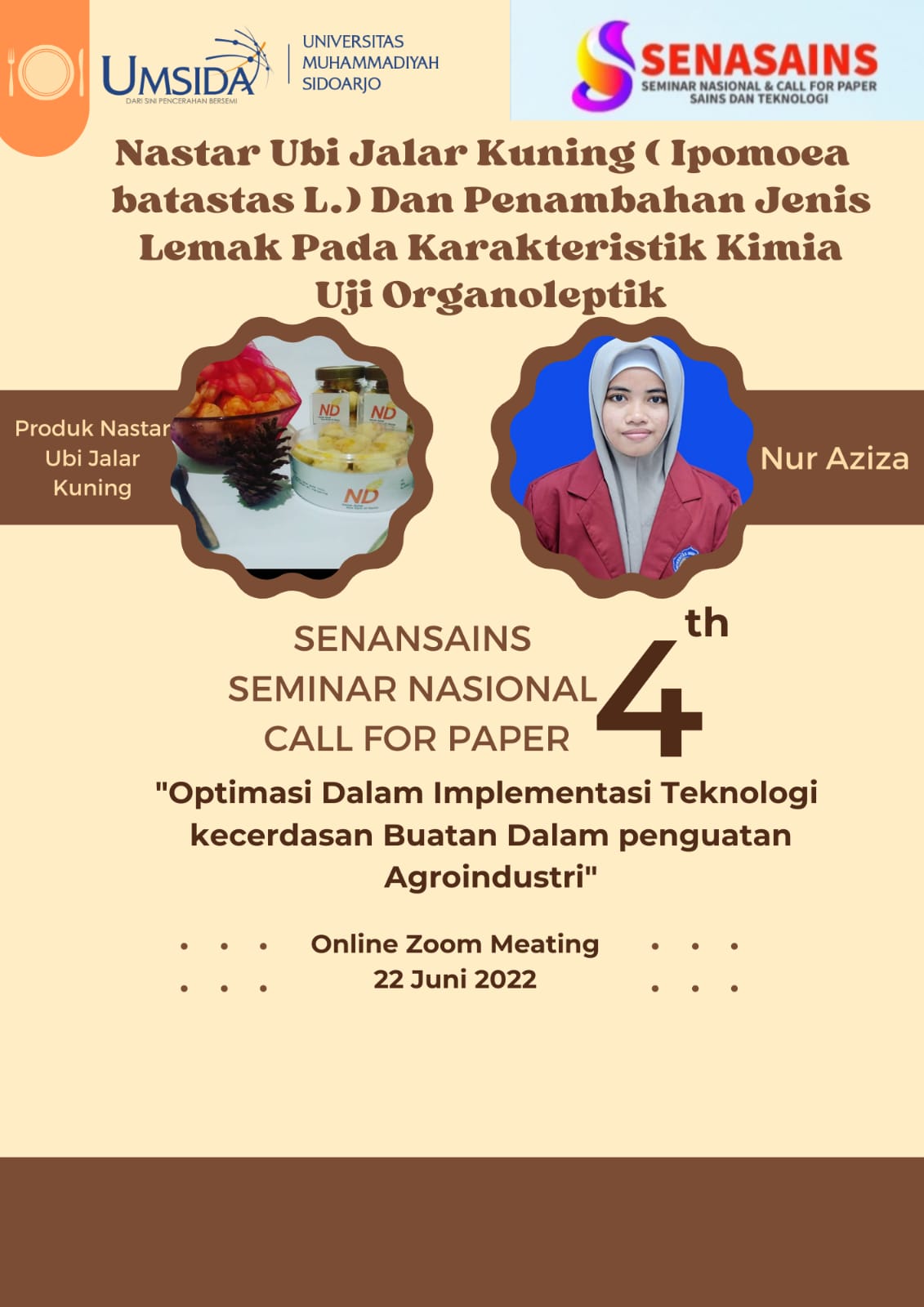Yellow Sweet Potato Nastar(Ipomoea Batatas L.) And The Addition Of Fat Type On Chemical Characteristics of Organoleptic Test
Nastar Ubi Jalar Kuning (Ipomoea Batatas L.) Dan Penambahan Jenis Lemak Pada Karakteristik Kimia Uji Organoleptik
DOI:
https://doi.org/10.21070/pels.v2i2.1197Keywords:
Butter, Margarine, Nastar, Yellow Sweet Potato, WebsiteAbstract
Dependence on flour needs to be reduced by utilizing local food ingredients that can enrich the active compounds in nastar cakes. The distinctive taste of yellow yam flour provides an innovative new taste of nastar with a combination of sweetness from chocolate jam. The comparison between yellow sweet potato flour and cornstarch in nastar cakes will provide a new taste and increase the nutritional content and as a natural coloring agent in the manufacture of pastries. The proportion of use of cornstarch in sweet potato nastars is used as a softener in pastries and cakes due to the nature of this cornstarch which can bind water to the dough so that the texture is softer and denser. This study aims to determine the sensory properties of nastar cookies with variations of yellow sweet potato flour and cornstarch with the addition of fat types so as to get the right formula. Organoleptic tests carried out included color, taste and taste. Test respondents used a sensory preference test (hedonic rating) with 30 panelists. By using the hedonic test and the results are expressed in numbers 1-5. 1 = strongly dislike, 2 = dislike, 3 = neutral, 4 = like, 5 = very much like. The hedonic test is the most widely used test to measure the level of liking for the product where the panelists express personal impressions about good or bad. conducting organoleptic tests, namely panelists, a laboratory consisting of a preparation room, waiting room and discussion room. The way to do the orgnoleptic test is that the presenter prepares the sample in the preparation room, for the panelists to be in the discussion room to taste the sample that has been prepared by the presenter. Panelists fill out the forum that has been prepared by the presenter in the discussion room. The foam consists of color, taste, and aroma tests using hedonic tests and the results are expressed in numbers 1-5.
Downloads
References
Widyaningtyas dan Hadi. 2015. Jurnal Pangan dan Agroindustri Vol. 3 No.2 p.417-423. Pengaruh Jenis Dan Konsentrasi Hidrokoloid (Carboxy Methyl Cellulose, Xanthan Gum, Dan Karagenan) Terhadap Karakteristik Mie Kering Berbasis Pasta Ubi Jalar Varietas Ase Kuning. Halaman 417-418, diakses pada tanggal 19 Januari 2022.
Kent NL dan Evers AD, 1994. Tecnology Of Cereals; An Introduction For Student Of Food Science And Agriculture. Ed ke-4. Oxford: Elseveir Scinence Ltd.
Sarwono, B. Ubi Jalar. Penebar Swadaya. Jakarta. 2005.
Hanifah Dwiyani, 2013. Formulasi Biskuit Subsitusi Tepung Ubi Kayu Dan Ubi Jalardengan Penambahan Isolat Protein Kedelai Serta Mineral, Fe Dan Zn Untuk Balita Kurang Gizi. Skripsi, 1-83 [5] Agustina, T. 2013. Pastry. Semarang : Universitas Negeri Semarang.
Winarno, F.G. 2004. Kimia Pangan dan Gizi. Jakarta : PT Gramedia Pustaka Utama.
Setyawan, B. 2015. Budidaya Umbi-Umbian Padat Nutrisi. Yogyakarta: Pustaka Baru Press.
Murtiningsih dan Suyanti. 2011. Membuat Tepung Umbi dan Variasi Olahannya. Jakarta : Agromedia Pustaka.
Nogueira, A., G, Sehn., A, Rebellato., J, Coutinho., H, Godoy., Y, Chang.,C, Steel and M, Clerici. 2018.Yellowsweet potato flour: use insweet bread processing to increaseβ-carotene content and improve quality. Journal Anais da Academia Brasileira de Ciências 90(1): 283-293 (Annals of the Brazilian Academy of Sciences). Universidade Estadual de Campinas, Rua Monteiro Lobato, Universidade Estadual de SantaCatarina, Universidade Estadualde Santa Cruz.
Hartono, Stefani. “Optimasi Formula Dan Proses Pembuatan Muffin Berbasis Substitusi Tepung Komposit Jagung Dan Ubi Jalar Kuning”. Skripsi. Fakultas Teknologi Pertanian Institut Pertanian Bogor. 2012.
Kusnandar, F. 2011. Kimia Pangan: Kompnen Makro. Dian Rakyat.Jakarta.
Winarno, F,G. 2001. Kimia Pangan dan Gizi. PT. Gramedia Pustaka Utama. Jakarta.




